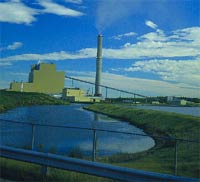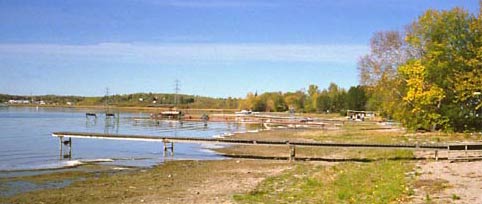 Alberta's WaterIntroductionPublications Climate Change Industrial Impacts Agricultural Impacts Urban Impacts Biodiversity Loss Definitions Links Site Map |
 |
|
 |
| Sundance Powerplant on the south shore of Lake Wabamun |
Sediment cores from three central Alberta lakes were analyzed for trace metals and polycyclic aromatic hydrocarbons (PAHs) to determine if local coal-fired power plants have affected sediment quality. In Wabamun Lake, with four nearby power plants, sediment concentrations of trace metals, including mercury (Hg), copper, lead, arsenic, and selenium, have increased by 2- to 10-fold over the past century. Trace metal enrichments were less pronounced in Lac Ste. Anne and Pigeon Lake, 20 km north and 70 km south, respectively, of Wabamun Lake. Trace metal concentrations in Wabamun Lake sediments began to increase with the first power plant operations in the mid-1950s. Current anthropogenic Hg flux (18-27 µg m-2 yr-1) accounts for 85% of total Hg flux to Wabamun Lake. Anthropogenic PAH flux to Wabamun Lake (73-114 µg m-2 yr-1) is 2-6 times higher than in Lac Ste. Anne and Pigeon Lake, respectively. Without improvement in trace metal and PAH emission controls, further expansion of coal-based industry in the Wabamun region will continue to adversely affect sediment quality in local lakes.



 Lake Wabamun
Lake Wabamun